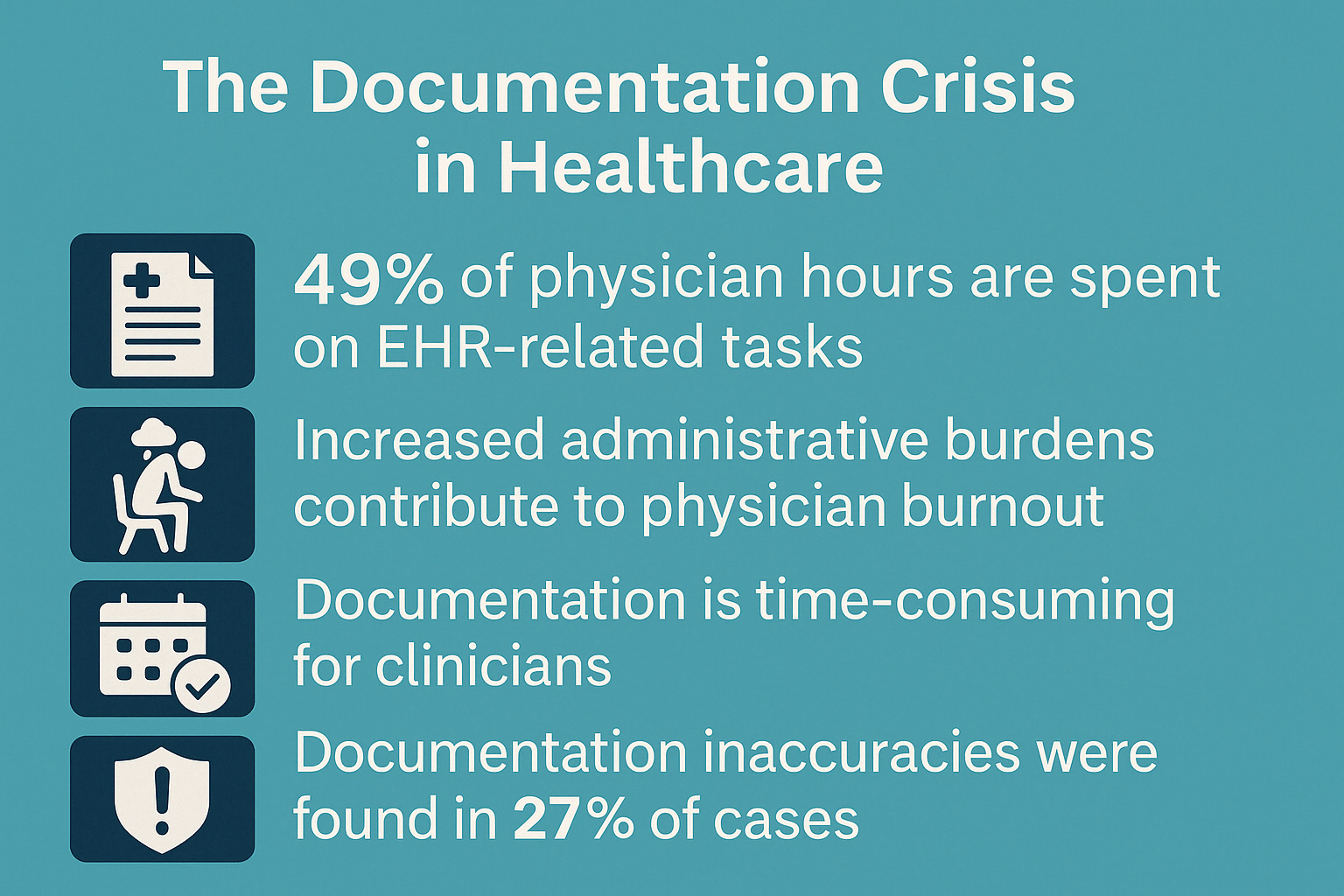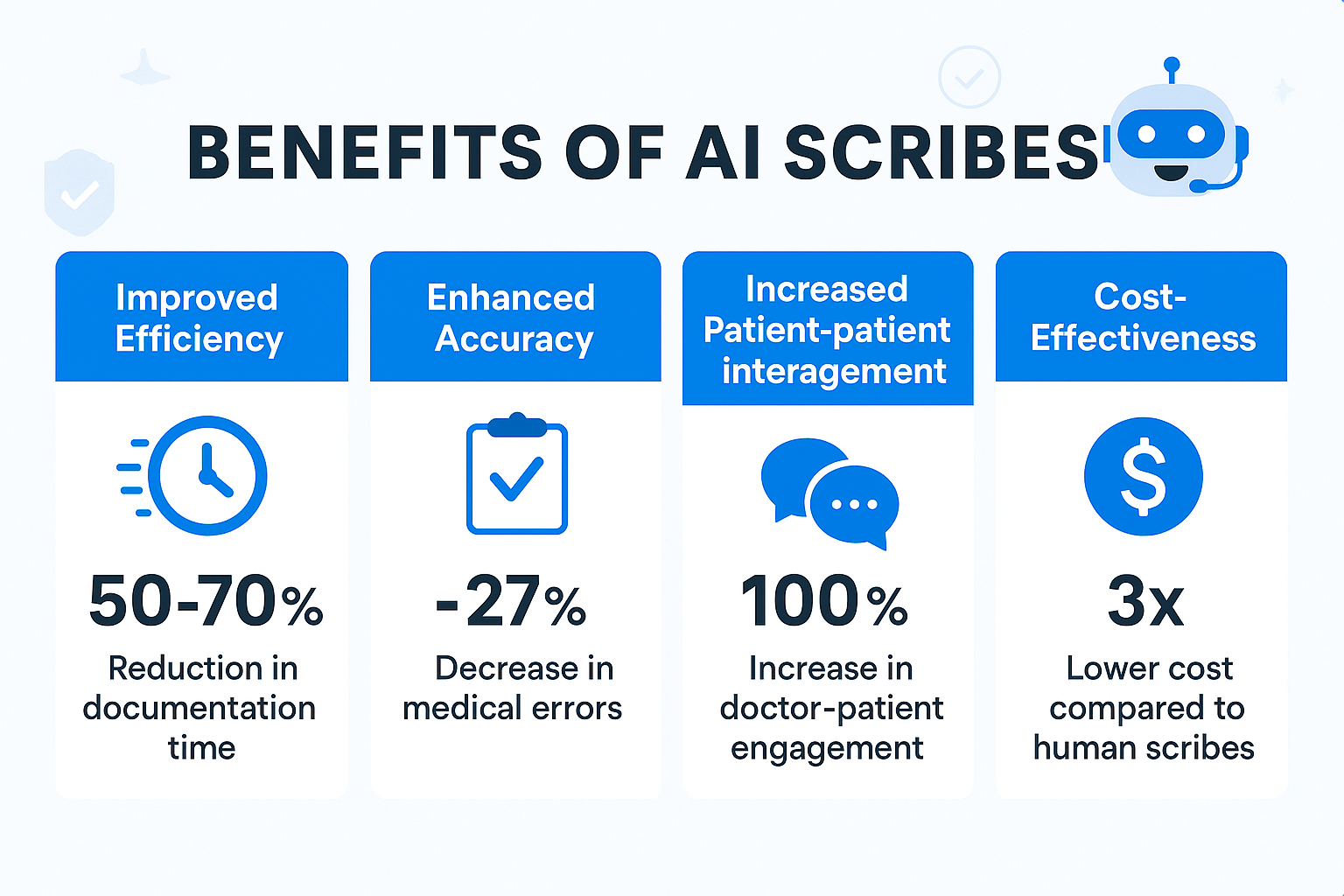How AI Medical Scribes Improve Workflow Efficiency without Adding Extra Work

Doctors and nurses spend a lot of time on documentation, often taking them away from patient care. Fortunately, AI Scribes can help! They do this by transcribing conversations and offering clinical recommendations automatically allowing healthcare staff to focus more on their patients instead of paperwork. And unlike traditional human scribes, AI scribes work in the background, reducing manual data entry without adding extra steps. As a result, they save time, improve accuracy, reduce burnout, and simplify daily workflows.
The Documentation Crisis in Healthcare

For many healthcare professionals, documentation has become one of the biggest challenges in their daily routine. That's because doctors and nurses spend hours each day updating Electronic Health Records (EHRs), often at the cost of their personal well-being.
According to the Administrative Burden on Palliative Academic Physicians, each clinicians spends about 5,300 minutes a year on required administrative tasks. This is roughly equivalent to 11 clinical days that could have been used for patient care.
This growing burden isn't just frustrating for your medical staff, it also affects patients. When healthcare providers are busy typing notes instead of engaging with patients, communication can suffer, care quality can decline, and clinician-patient trust can erode.
Additionally, rushed note-taking can lead to errors, inconsistencies, and missing medical record details, affecting treatment decisions, patient safety, and reimbursement. They allow clinicians to reclaim their valuable time while ensuring precise and efficient documentation.
How AI Medical Scribes Work
An AI medical scribe simplifies your medical staff's documentation process so they can dedicate more attention to patient needs. Here's how it works:
1. Real-Time Transcription
With patient consent, the AI scribe listens during visits, capturing the conversation with the medical staff. Using advanced voice recognition technology, it transcribes the dialogue in real time, noting important details, symptoms, and medical history without requiring the clinician to take notes.
2. Formatting Notes
After transcribing, the medical scribe processes the information into your preferred note format. This ensures that key medical terms and details are accurately represented according to your standards.
3. Review, Edit, and Save
Clinicians can then review the transcribed notes, make any necessary edits, and save. In addition to that, medical staff can copy the data into the EHR system, ensuring accurate information.
4. Providing Clinical Recommendations
Beyond documentation, integrated AI Scribe and CDS tools like DocAssistant can analyze patient data and provide clinical recommendations based on past medical history, symptoms, and treatment guidelines. As a result, they can assist you in making informed decisions, enhancing diagnostic accuracy and treatment planning.
5. Patient Instructions
Some AI scribes, like DocAssistant, have a feature that allows medical practitioners to view, edit, and print patient instructions. This ensures that your patients receive clear and concise information about their care.
Benefits of AI Scribes
AI scribes offer healthcare professionals numerous advantages by reducing administrative burdens and enhancing workflow efficiency.
Improved Efficiency
AI scribes can greatly reduce your medical team's documentation time. Traditionally, clinicians spend countless hours each week on administrative tasks, including note-taking and updating EHRs. An AI-powered scribe helps by automatically transcribing patient interactions in real time and generating structured medical notes.
Minimizing after-hours paperwork contributes to better work-life balance for healthcare providers. With less time spent on administrative tasks, physicians experience lower stress levels and increased job satisfaction, which can translate into better patient interactions, and less turnover for the hospital/clinic. As a result, this leads to improved patient experiences and enhances care quality.
Enhanced Accuracy
Medical documentation errors can lead to miscommunication, delayed treatment, and potential patient safety risks. To mitigate these risks, AI Scribes can be deployed to capture patient/clinician conversation in real time, generating precise, structured notes based on your preferred format.
An electronic scribe also reduces human errors since it can consistently recognize important medical terms and ensure every detail is accurately recorded. Furthermore, documenting information instantly prevents healthcare practitioners from relying on memory to input data after patient visits. As a result, it reduces the risk of misremembering important details, ensuring safer treatment decisions.
Increased Patient Interaction
Another advantage of using an AI medical note-taking system is that it increases meaningful patient interaction. Basically, it transcribes your conversation once you press record. So, instead of spending considerable time writing or typing notes, you can give patients your full attention.
In this way, you can engage more effectively with your patients, building better communication and rapport. After all, patients appreciate when you actively listen and respond to their concerns without the barrier of a computer or the feeling that you are rushing through the encounter, which will naturally happen when the clinician has to budget time for note writing.
Cost-Effectiveness
AI-powered scribes offer a more cost-effective alternative to hiring human medical scribes. When you hire a human scribe, it involves ongoing expenses such as salaries, benefits, training, and potential turnover costs. In contrast, AI scribes function as a relatively low cost subscription-based service, eliminating payroll expenses and reducing overhead costs. I
Unlike human scribes, AI-powered solutions can operate 24/7 without breaks, sick leave, or shift limitations, so you'll have continuous documentation support. Moreover, AI scribes don't require additional training to adapt to different medical specialties, making them a scalable and flexible solution.
Overall, medical scribes deliver consistent accuracy, minimize errors, and integrate easily with existing systems at a fraction of the long-term cost.

Implementing AI Scribes in Healthcare Settings
Integrating an AI-powered scribe into your workflow requires careful planning to ensure a smooth transition and maximize its benefits. To guide you, here are steps on how to properly implement it:
Assess Organizational Needs
Before adopting an AI scribe, it's important to evaluate your healthcare organization's documentation challenges and workflow requirements. In this way, you’re able to understand patient volume, note complexities, and administrative burdens that helps determine if a digital scribe fits your operational goals.
As a whole, a well-informed assessment ensures that implementing an AI-powered scribe effectively addresses your organization's needs, leading to improved productivity.
Select the Right Technology
When selecting an AI scribe, make sure to look at its features and ease of use. The best option should accurately capture conversations, support different note formats, and fit naturally into your work flow. A user-friendly interface and quick onboarding process will also enhance adoption among your team.
It's also important to consider the software's security and privacy. At a minum it should follow be HIPPA Compliant. It's also beneficial if the platform anonymizes patient data and secures it with advanced protocols to strengthen security.
Lastly, speech recognition accuracy and reliable customer support can significantly affect the technology's effectiveness for your team.
Integration
To integrate the software into your routine, introduce it gradually during low-pressure scenarios to help staff become comfortable with the technology. Establish clear guidelines for when and how to use the scribe to maximize its benefits. And, regularly ask users for feedback and make adjustments based on their experiences.
Challenges and Considerations
Integrating AI scribes into your practice may offer several benefits, but it's also important to recognize the challenges and considerations that come with it. Addressing these issues early lets you maximize its advantages while minimizing workflow disruptions.
Data Security and Privacy
Using an AI Scribe can make medical documentation easier, but keeping patient information secure should always be a top priority. After all, these systems process sensitive data, so it's important to choose a platform that follows strict privacy regulations. Also, look for digital scribes that use advanced security protocols to keep records safe from data breaches.
Regular security checks and monitoring can add another layer of protection, so only approved staff members can handle patient information. Training your team on proper data privacy practices also helps create a security-conscious environment.
With that said, when you prioritize privacy and security, you can confidently use AI scribes to improve efficiency without compromising patient trust.
Resistance to Change
While AI scribes can simplify documentation, some healthcare professionals may be reluctant to adopt it. Concerns about workflow disruptions, adapting to new technology, or losing the personal aspect of note-taking create hesitation. Some may also question whether AI-generated notes can accurately capture patient interactions.
To ease these concerns, consider gradually introducing the software to your medical team. Demonstrating the benefits through real-world examples, encouraging open discussions, and providing continuous support can build trust in the system. As clinicians see how AI reduces paperwork and gives them more time for patient care, they may become more comfortable incorporating it into their routine.
Simplify Note-Taking with DocAssistant
An AI assistant makes medical documentation easier by reducing paperwork, improving accuracy, and giving healthcare providers more time with their patients. While adjusting technology can take time, choosing the right system and offering proper support can help smooth the transition.
If you're looking for a reliable AI-powered scribe, DocAssistant offers an intuitive and secure solution. Sign up today to experience how AI documentation can save time and enhance patient care!
About the Author
Nathan Murray, M.D. Emergency Medicine - Founder of DocAssistant
Dr. Nathan Murray is an Emergency Medicine trained physician and the founder of DocAssistant. With years of frontline clinical experience, Dr. Murray is passionate about using AI to streamline medical documentation and enhance clinical decision making.



